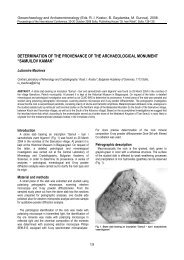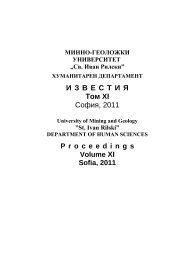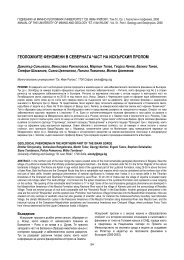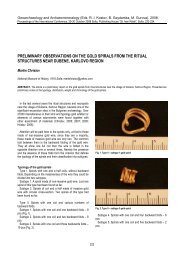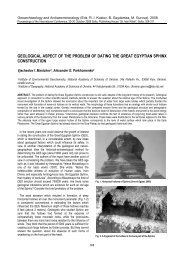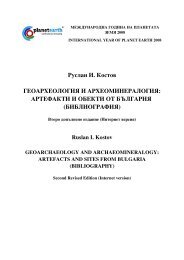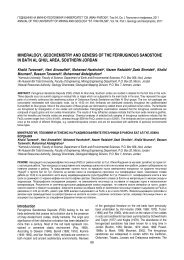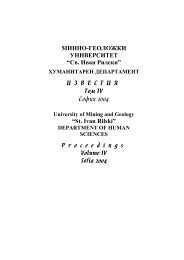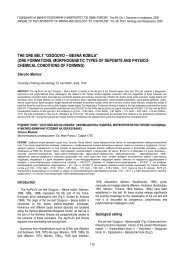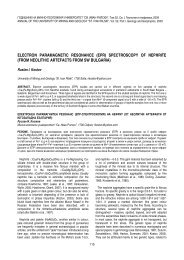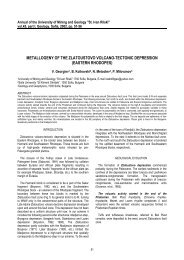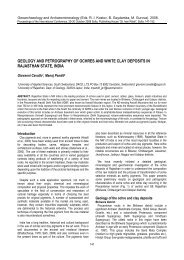prehistoric rock sanctuaries in the eastern rhodopes and some other ...
prehistoric rock sanctuaries in the eastern rhodopes and some other ...
prehistoric rock sanctuaries in the eastern rhodopes and some other ...
Create successful ePaper yourself
Turn your PDF publications into a flip-book with our unique Google optimized e-Paper software.
Geoarchaeology <strong>and</strong> Archaeom<strong>in</strong>eralogy (Eds. R. I. Kostov, B. Gaydarska, M. Gurova). 2008.Proceed<strong>in</strong>gs of <strong>the</strong> International Conference, 29-30 October 2008 Sofia, Publish<strong>in</strong>g House “St. Ivan Rilski”, Sofia, 180-184.PREHISTORIC ROCK SANCTUARIES IN THE EASTERN RHODOPES AND SOME OTHERMOUNTAIN REGIONS IN BULGARIAAna RadunchevaNational Institute of Archaeology <strong>and</strong> Museum, Bulgarian Academy of Sciences, 1000 SofiaABSTRACT. The aim of <strong>the</strong> present paper is <strong>the</strong> study of <strong>the</strong> period of <strong>the</strong> establishment <strong>and</strong> <strong>the</strong> period of <strong>the</strong> most <strong>in</strong>tensive use of <strong>the</strong> <strong>rock</strong><strong>sanctuaries</strong> <strong>in</strong> <strong>the</strong> Neolithic <strong>and</strong> <strong>the</strong> Chalcolithic <strong>in</strong> THE Eastern Rhodopes (Sou<strong>the</strong>rn Bulgaria) <strong>and</strong> <strong>some</strong> o<strong>the</strong>r mounta<strong>in</strong> regions <strong>in</strong>Bulgaria. Attention is drawn on <strong>some</strong> elements of <strong>the</strong> sanctuary plan <strong>and</strong> <strong>in</strong>terior as well as <strong>some</strong> aspects of <strong>the</strong> ritual practices.The <strong>prehistoric</strong> <strong>rock</strong> <strong>sanctuaries</strong> form a dense networkcover<strong>in</strong>g <strong>the</strong> high parts of <strong>the</strong> mounta<strong>in</strong>s. In few cases, <strong>in</strong> <strong>the</strong>planes, <strong>the</strong>y are located on <strong>rock</strong>y hills. Until recently it wasbelieved that <strong>the</strong> network of <strong>rock</strong> <strong>sanctuaries</strong> has covered only<strong>the</strong> Eastern Rhodopes Mounta<strong>in</strong> but we already know that <strong>the</strong>ywere situated on <strong>the</strong> summits <strong>and</strong> <strong>the</strong> slopes of <strong>the</strong> entireRhodopes Mounta<strong>in</strong> <strong>and</strong> almost on all mounta<strong>in</strong>s at <strong>the</strong> CentralBalkans – <strong>the</strong> Sredna Gora Mounta<strong>in</strong>s, <strong>the</strong> Stara Plan<strong>in</strong>aMounta<strong>in</strong>s, etc. Each site had a different plan of <strong>the</strong> temenosarea, which was closely related to <strong>the</strong> specific rituals <strong>and</strong> <strong>the</strong>religious beliefs (Raduncheva, 2003, 79-138). The <strong>rock</strong><strong>sanctuaries</strong> also met certa<strong>in</strong> requirements for astronomicobservations, which were an extremely important part of <strong>the</strong>rituals performed <strong>the</strong>re. The <strong>sanctuaries</strong> were situated onplaces where magnetic anomalies have been found <strong>and</strong> <strong>the</strong><strong>rock</strong> thrones <strong>and</strong> bas<strong>in</strong>s were situated on <strong>the</strong> spots of <strong>the</strong>anomalies, a circumstance that had <strong>in</strong>fluence on <strong>the</strong> quality of<strong>the</strong> water <strong>in</strong> <strong>the</strong> bas<strong>in</strong>s. It probably had an <strong>in</strong>fluence over <strong>the</strong>reactions of <strong>the</strong> people who stood for a long period near <strong>the</strong>thrones or were seat<strong>in</strong>g on <strong>the</strong>m (Stoev, Muglova, 1996).notwithst<strong>and</strong><strong>in</strong>g <strong>the</strong> fact that <strong>the</strong>y consisted of identical orsimilar elements. The various components compris<strong>in</strong>g <strong>the</strong> planof <strong>the</strong> temenos area have been chosen accord<strong>in</strong>g to <strong>the</strong> cultpractices <strong>and</strong> <strong>the</strong> rituals performed <strong>the</strong>re. As I have mentionedmany times, <strong>the</strong> religious beliefs def<strong>in</strong>ed <strong>the</strong> type of <strong>the</strong> <strong>rock</strong>effigies <strong>and</strong> <strong>the</strong> way <strong>the</strong>y have been made. In <strong>some</strong> cases <strong>the</strong>natural curves of <strong>the</strong> <strong>rock</strong>s have been used, <strong>some</strong>times <strong>the</strong>yneeded additional modification <strong>and</strong> have been slightly cut <strong>in</strong>order to be given a shape required by <strong>the</strong> ritual, <strong>and</strong><strong>some</strong>times monumental sculptures have been made from<strong>rock</strong>s <strong>and</strong> <strong>rock</strong> pieces. In <strong>the</strong> sanctuary on <strong>the</strong> Harmankayapeak near <strong>the</strong> Gassak neighbourhood <strong>in</strong> <strong>the</strong> village of DolnaChobanka, <strong>the</strong> anthropomorphic effigies were made of largeror smaller pieces of <strong>rock</strong>s, which were carefully arranged to fiteach o<strong>the</strong>r (Fig. 1). In most cases <strong>the</strong> cuts <strong>and</strong> <strong>the</strong> reliefs weremade on <strong>the</strong> horizontal as well as on vertical <strong>rock</strong>s. Both, <strong>the</strong>sculptures cut <strong>in</strong>to <strong>the</strong> <strong>rock</strong>s <strong>and</strong> <strong>the</strong> carv<strong>in</strong>gs, f<strong>in</strong>d parallelsamong <strong>the</strong> Neolithic <strong>and</strong> <strong>the</strong> Chalcolithic f<strong>in</strong>ds discovereddur<strong>in</strong>g excavations of <strong>prehistoric</strong> settlements.The elements form<strong>in</strong>g <strong>the</strong> <strong>prehistoric</strong> <strong>rock</strong> <strong>sanctuaries</strong>consisted of anthropomorphic images or substantial parts of<strong>the</strong>m, human heads ma<strong>in</strong>ly; animal figures – lions, leopards,bears, horses, serpents, tortoises <strong>and</strong> hedgehogs; birds –eagles <strong>and</strong> swans; various thrones <strong>and</strong> altars, ritual pits carved<strong>in</strong>to <strong>the</strong> <strong>rock</strong>s, natural caves or caves cut <strong>in</strong>to <strong>the</strong> <strong>rock</strong>s,stairways lead<strong>in</strong>g to nowhere or should we say to heaven,water reservoirs (wells <strong>and</strong> bas<strong>in</strong>s cut <strong>in</strong>to <strong>the</strong> <strong>rock</strong>s) <strong>and</strong> watersources (spr<strong>in</strong>gs or small streams) flow<strong>in</strong>g through <strong>the</strong> territoryof <strong>the</strong> sanctuary, niches cut <strong>in</strong>to <strong>the</strong> <strong>rock</strong>s, etc. There areeffigies of suns <strong>and</strong> moons <strong>in</strong> various phases as well assyncretic effigies of creatures hav<strong>in</strong>g both anthropomorphic<strong>and</strong> zoomorphic features – sph<strong>in</strong>xes, sirens-birds with humanfaces or sculptures of mythological creatures with human faces<strong>and</strong> serpent’s bodies. The comb<strong>in</strong>ation of different elementsresulted <strong>in</strong> a great variety of <strong>rock</strong> <strong>sanctuaries</strong>. Today we areaware of <strong>the</strong> fact that all sacred places differ from each o<strong>the</strong>r180Fig. 1. Human’s head made of <strong>rock</strong> pieces cut to fit each o<strong>the</strong>r (right);parallel image from Israel (left)The time when <strong>the</strong> <strong>rock</strong> cult places <strong>and</strong> <strong>sanctuaries</strong> wereestablished has become a constant research issue <strong>in</strong> <strong>the</strong>recent years <strong>and</strong> by default <strong>the</strong>y are dated to <strong>the</strong> Thracianperiod. The fact that <strong>the</strong> type of Neolithic <strong>and</strong> Chalcolithic f<strong>in</strong>dsfrom <strong>prehistoric</strong> settlements precisely correspond to <strong>the</strong> type of
structures cut <strong>in</strong>to <strong>the</strong> <strong>rock</strong>s, provide a reason to date <strong>the</strong>establishment of <strong>the</strong> entire sanctuary network to <strong>the</strong> Neolithic<strong>and</strong> <strong>the</strong> Chalcolithic. Here are <strong>some</strong> arguments support<strong>in</strong>g <strong>the</strong>proposed date.The follow<strong>in</strong>g sequence has been observed <strong>in</strong> <strong>the</strong><strong>sanctuaries</strong> under research: various effigies were cut <strong>in</strong>to <strong>the</strong>ma<strong>in</strong> <strong>rock</strong>s <strong>and</strong> were covered after that by layers yield<strong>in</strong>gpottery <strong>and</strong> f<strong>in</strong>ds dated ma<strong>in</strong>ly to <strong>the</strong> second half of <strong>the</strong>Chalcolithic <strong>and</strong> <strong>in</strong> a few cases – to <strong>the</strong> Neolithic. This factprovides ground to date <strong>the</strong> majority of <strong>the</strong> <strong>rock</strong> structures <strong>and</strong><strong>sanctuaries</strong> to <strong>the</strong> f<strong>in</strong>al Late Chalcolithic. After <strong>the</strong> end of <strong>the</strong>Chalcolithic, <strong>the</strong>se cult places were ab<strong>and</strong>oned for a period ofca. 2000 years. It was as late as <strong>the</strong> Late Bronze Age whenhuman activity is recorded aga<strong>in</strong> although <strong>the</strong> newcomers usedonly certa<strong>in</strong> sectors from <strong>the</strong> old temene. Sectors from <strong>the</strong><strong>prehistoric</strong> settlements cont<strong>in</strong>ued to be used <strong>in</strong> <strong>the</strong> Early IronAge as well.This chronological pattern is recorded everywhere – <strong>in</strong> <strong>the</strong><strong>sanctuaries</strong> of both <strong>the</strong> Eastern <strong>and</strong> <strong>the</strong> Western RhodopeMounta<strong>in</strong>s (Belantash near <strong>the</strong> village of Vrata, AssenovgradRegion, Perperek near <strong>the</strong> village of Gorna Krepost, KardzhaliRegion, Tatul near <strong>the</strong> village of Dolna Chobanka, Raven-Center, Raven-North, Raven-West, Adzhioluk, Kazan Beyug,Chukovo, Chomakovo, Momchilgrad Region, Fot<strong>in</strong>ovo <strong>and</strong>Benkovski, Kirkovo Kale locality, “<strong>the</strong> Tower of Babylon” <strong>and</strong>Uch Kale near <strong>the</strong> town of Dzhebel, Adata, KrumovgradRegion, Pchelarovo, Haskovo Region, at Dzhambaz Tepe <strong>in</strong>Plovdiv, <strong>the</strong> numerous cult places along <strong>the</strong> Borovitsa <strong>and</strong>Dazhdovnitsa Rivers, at <strong>the</strong> village of Dzhanka, Zhenda near<strong>the</strong> villages of Nochevo <strong>and</strong> Angel Voyvoda, Kardjali Region,at <strong>the</strong> Bosilkovo neighbourhood <strong>in</strong> <strong>the</strong> village of Davidkovo,Smolyan Region, at <strong>the</strong> village of Dolno Dryanovo,Blagoevgrad Region <strong>and</strong> <strong>in</strong> <strong>the</strong> <strong>sanctuaries</strong> <strong>in</strong> <strong>the</strong> Sredna GoraMounta<strong>in</strong>s (at Buzovgrad, near <strong>the</strong> village of Karnara on <strong>the</strong>Stryama River, <strong>in</strong> <strong>the</strong> Turchov Kamak locality (Kitov, 1979), adozen of sites near <strong>the</strong> town of Strelcha (Vasilev, 2007) as wellas <strong>in</strong> <strong>the</strong> Stara Plan<strong>in</strong>a Mounta<strong>in</strong>s (at <strong>the</strong> village of Gortalovo,Pleven Region (Mikov, 1982; etc.). To give <strong>the</strong> reader only aclue for <strong>the</strong> number of <strong>the</strong> <strong>rock</strong> <strong>sanctuaries</strong> one can mentionthat only <strong>in</strong> <strong>the</strong> Momchilgrad Region <strong>the</strong>ir number exceeds 100<strong>and</strong> each survey adds new sites to <strong>the</strong> map. Thearchaeological excavations at <strong>the</strong> Arkata locality at <strong>the</strong> villageof Oreshare made by S. Ivanova <strong>in</strong> 2008 supported <strong>the</strong>stratigraphic observations of <strong>the</strong> <strong>sanctuaries</strong> listed above.About 80% of <strong>the</strong> sherds collected dur<strong>in</strong>g <strong>the</strong> surveys <strong>and</strong> <strong>the</strong>excavations are dated to <strong>the</strong> Late Chalcolithic; certa<strong>in</strong> ritualobjects such as ceramic <strong>and</strong> triangular bone figur<strong>in</strong>es as wellas small ritual arrows made of fl<strong>in</strong>t <strong>and</strong> agate are also dated to<strong>the</strong> same period. Large size stone tools (axes <strong>and</strong> adzes) usedprobably for cutt<strong>in</strong>g <strong>the</strong> soft <strong>rock</strong>s at <strong>the</strong> <strong>sanctuaries</strong> have alsobeen found. It is worth mention<strong>in</strong>g that 90% of <strong>the</strong> f<strong>in</strong>ds yieldedby <strong>the</strong> large pits cut <strong>in</strong>to <strong>the</strong> <strong>rock</strong>s of <strong>the</strong> sanctuary near <strong>the</strong>village of Pchelarovo, Haskovo Region are dated to <strong>the</strong> end of<strong>the</strong> Late Chalcolithic. The f<strong>in</strong>ds comprise complete <strong>and</strong>fragmented ceramic vessels, marble (Shukerova, 1985) <strong>and</strong>clay figur<strong>in</strong>es as well as stone tools. These f<strong>in</strong>ds were found <strong>in</strong>pits whose depth <strong>some</strong>times reached several metres. Thetradition of <strong>the</strong> ritual pits came from <strong>the</strong> Early Neolithic <strong>and</strong>survives through <strong>the</strong> entire Chalcolithic period.Fig. 2. Tatul sanctuary, view from <strong>the</strong> West.181
lamps) have been considered m<strong>in</strong>iature models of <strong>the</strong> cultplaces <strong>in</strong> <strong>the</strong> mounta<strong>in</strong>s <strong>and</strong> <strong>some</strong> of <strong>the</strong>m probably wereconsidered as altars for offer<strong>in</strong>gs which is <strong>the</strong> case of a f<strong>in</strong>dfrom <strong>the</strong> Tell near <strong>the</strong> village of Sedlare, Momchilgrad Region.There is a human head on <strong>the</strong> table strongly resembl<strong>in</strong>g <strong>the</strong><strong>rock</strong> head of a <strong>rock</strong> altar (badly damaged by <strong>the</strong> archaeologicalexcavations) at <strong>the</strong> Tatul sanctuary.to nowhere <strong>in</strong> <strong>the</strong> middle room of <strong>the</strong> large <strong>rock</strong> temple. Thethrones are situated <strong>in</strong> <strong>the</strong> same room, one of <strong>the</strong>m hav<strong>in</strong>glions on <strong>the</strong> back <strong>and</strong> a seated figure beside; it is a figure of a“man with cat ears” – a character known from <strong>the</strong> frescoes <strong>and</strong>reliefs on <strong>the</strong> walls of <strong>the</strong> Çatalhöyük temple, dated to <strong>the</strong> VIIImillennium BC. There are several altars <strong>in</strong> <strong>the</strong> next room,which beyond any doubt are <strong>prehistoric</strong> <strong>and</strong> at least two of<strong>the</strong>m have eyes shaped accord<strong>in</strong>g to <strong>the</strong> traditions of <strong>the</strong> LateChalcolithic. Follow<strong>in</strong>g this l<strong>in</strong>e we can try to reconstruct <strong>the</strong>concept of <strong>the</strong> <strong>prehistoric</strong> sanctuary builder – <strong>the</strong> largesttemple is <strong>in</strong> <strong>the</strong> lap of <strong>the</strong> supreme god who protects it.Ano<strong>the</strong>r <strong>in</strong>terpretation is also possible – <strong>the</strong> giant is offer<strong>in</strong>g <strong>the</strong>temple to <strong>the</strong> deities, hold<strong>in</strong>g it <strong>in</strong> his left h<strong>and</strong> <strong>and</strong> rais<strong>in</strong>g hisright arm to salute <strong>the</strong>m. The figure was related to o<strong>the</strong>rstructures – <strong>the</strong> large bas<strong>in</strong>, <strong>the</strong> temple situated to <strong>the</strong> East,<strong>the</strong> sacred road, <strong>the</strong> thrones <strong>and</strong> <strong>the</strong> various <strong>rock</strong> structures on<strong>the</strong> plateau; a great part of which was destroyed by <strong>the</strong> recentexcavations. All mentioned above makes def<strong>in</strong>itions such as“city of <strong>the</strong> <strong>rock</strong> people”, “city”, “capital city”, “Sitalk’s palace”,“site of an oracle of Dionysus”, “Perperikon”, “Pergamum”,“Pergan”, etc. sound absurd. In fact we are fac<strong>in</strong>g a brightexample of material expression of <strong>the</strong> supreme emanation ofbeliefs <strong>and</strong> <strong>the</strong> complex organization of spirituality <strong>in</strong> <strong>the</strong><strong>prehistoric</strong> period. Many authors wrote about <strong>the</strong> lack ofcredibility of <strong>the</strong>se def<strong>in</strong>itions as well (Atanasov, 2002, 89-96;Iliev, 2007, 89-98; Tacheva, 2007, 251-259; Rabadjiev, 2008).Fig. 3. Tatul sanctuary, aerial photograph (above) <strong>and</strong> a human-likeimage (below)There are not many aerial photographs of <strong>the</strong> <strong>sanctuaries</strong>.However, such a photograph taken years ago is available for<strong>the</strong> Perperek sanctuary. It is clearly visible on this photographthat <strong>the</strong> sanctuary has <strong>the</strong> shape of a ly<strong>in</strong>g human figure(Ovcharov et al., 19). The second aerial photograph taken of<strong>the</strong> site revealed <strong>the</strong> ma<strong>in</strong> concept of <strong>the</strong> sanctuary plan. Itresembles a gigantic seated male figure hold<strong>in</strong>g with his leftarm <strong>in</strong> his lap <strong>the</strong> great <strong>rock</strong> temple. The right arm of <strong>the</strong> figureis bent at <strong>the</strong> elbow <strong>and</strong> raised to <strong>the</strong> shoulder with <strong>the</strong> palmturned outwards <strong>and</strong> f<strong>in</strong>gers tightly pressed to each o<strong>the</strong>r. Thepate of <strong>the</strong> giant’s head reaches <strong>the</strong> top of <strong>the</strong> hill <strong>and</strong> his legs– <strong>the</strong> foothill. The <strong>rock</strong>s shap<strong>in</strong>g <strong>the</strong> left arm, from <strong>the</strong> elbow to<strong>the</strong> palm are now destroyed. The only part preserved are <strong>the</strong>five f<strong>in</strong>gers, which <strong>in</strong> fact are “staircases” lead<strong>in</strong>g from nowhere183As we know <strong>the</strong> religious <strong>and</strong> <strong>the</strong> everyday life of <strong>the</strong><strong>prehistoric</strong> people have been managed <strong>and</strong> controlled by civil<strong>and</strong> religious structures function<strong>in</strong>g on various levels – familylevel, tribal level <strong>and</strong> related to <strong>the</strong> tribe alliances <strong>in</strong> <strong>the</strong> f<strong>in</strong>alLate Chalcolithic. The supreme power was exercised byrepresentatives of <strong>the</strong> supreme priesthood, who were <strong>in</strong> chargeof <strong>the</strong> ritual practices performed at <strong>the</strong> <strong>rock</strong> <strong>sanctuaries</strong>(Raduncheva, 2003, 75-138). Some of <strong>the</strong> rituals were closelyrelated to astronomical observations <strong>and</strong> calculations as wellas to different k<strong>in</strong>ds of predictions. The rituals were divided <strong>in</strong>totwo parts – profane <strong>and</strong> sacred. The profane part <strong>in</strong>cludedvarious performances, a <strong>the</strong>atre for <strong>the</strong> worshippers <strong>and</strong>pilgrims, who came to hear <strong>the</strong> will of <strong>the</strong> deities. The sacred(hidden) one was related to <strong>the</strong> astronomical knowledge <strong>and</strong>records, observations of movement of stars <strong>and</strong> celestialphenomena – an activity provid<strong>in</strong>g ground for precisepredictions of <strong>the</strong> future. This sacred knowledge wasaccumulated, kept <strong>and</strong> transferred from generation togeneration (Raduncheva, 2002, 78-111). It was also mostprobably directly related to <strong>the</strong> fact that <strong>the</strong> pilgrims visit<strong>in</strong>g <strong>the</strong><strong>sanctuaries</strong> dur<strong>in</strong>g various seasons or times of <strong>the</strong> day sawdifferent images as dem<strong>and</strong>ed by <strong>the</strong> sacred part of <strong>the</strong> ritual.ReferencesAtanasov, V. 2002. The ancient gold m<strong>in</strong>e Perperikon near <strong>the</strong>village of Stremtsi, Kurdjali District. – Ann. Univ. M<strong>in</strong><strong>in</strong>g<strong>and</strong> Geology, 45, Part 1, 89-96 (<strong>in</strong> Bulgarian).Drossler, R. 1967. Die Venus der Eiszeit. Prisma, Leipzig,269 S.Iliev, J. 2007. The Rhodope Mounta<strong>in</strong> accord<strong>in</strong>g <strong>the</strong> view of <strong>the</strong>ancient authors. – Rhodopica, 1, 89-98 (<strong>in</strong> Bulgarian).Kitov, G. 1979. The Thracian Mounds Near <strong>the</strong> Town ofStrelcha. Sofia, 32 p. (<strong>in</strong> Bulgarian).Mellaart, J. 1999. Under <strong>the</strong> volcano. – Cornocopia, 4, 77-97.
Mikov, V. 1929. Rock images from Bulgaria. – Notes Bulg.Hist. Soc., 7 (<strong>in</strong> Bulgarian).Nikolova, R., N. Genov. 2008. A Book about Bulgaria. Plovdiv.(<strong>in</strong> Bulgarian)Ovcharov, N. (A). In: Ovcharov, N., D. Kodjamanova. TheSacred Town Perperikon. Slavena, Varna, 48 p. (<strong>in</strong>Bulgarian)Ovcharov, N. (B). The Sanctuary of Orpheus at <strong>the</strong> Village ofTatul, Momchilgrad Region. Slavena, Varna, 24 p. (<strong>in</strong>Bulgarian)Ovcharov, N., D. Kodjamanova, M. Kamarev. The Sanctuary ofDyonisius at Perperikon. The Nor<strong>the</strong>rn Delphi.Popgeorgievi, 36 p. (<strong>in</strong> Bulgarian)Rabadjiev, K. 2008. About <strong>the</strong> temple of Orpheus at Tatul… orfor <strong>the</strong> responsibility of <strong>the</strong> archaeologist. – Anamnesis, 3,6, 2-8 (<strong>in</strong> Bulgarian).Raduncheva, А. 2002. The religious structure dur<strong>in</strong>g <strong>the</strong> LateChalcolithic. – Ann. Archaeol. Inst. <strong>and</strong> Museum, 78-111(<strong>in</strong> Bulgarian).Raduncheva, А. 2003. The Late Chalcolithic Society <strong>in</strong> <strong>the</strong>Bulgarian L<strong>and</strong>s. Excavations <strong>and</strong> Investigations, 32, Sofia(<strong>in</strong> Bulgarian).Raduncheva, А. 2006. About <strong>the</strong> role of <strong>the</strong> cave <strong>in</strong> <strong>the</strong> religionof <strong>prehistoric</strong> societies. – Proc. Archaeol. Inst., 39, 57-72(<strong>in</strong> Bulgarian).S<strong>and</strong>ars, N. 1968. Prehistoric Art <strong>in</strong> Europe. Baltimore, 350 p.Shukerova, A. 1985. Semi-f<strong>in</strong>ished marble small statue from<strong>the</strong> village of Pchelarovo, Kurdjali District. – Proc.Museums of South East Bulgaria, Plovdiv, 9 (<strong>in</strong> Bulgarian).Stoev, A., P. Muglova. 1996. Classification <strong>and</strong> functionalelements of cult sites <strong>in</strong> <strong>the</strong> Rhodope region, used forastronomical purposes. – In: Symposium “Cult Sites <strong>and</strong>Cult Practices <strong>in</strong> <strong>the</strong> Rhodopes”, Smolyan (<strong>in</strong> Bulgarian).Tacheva, M. 2007. Sources about <strong>the</strong> oracle of Dyonisius <strong>in</strong>Thrace <strong>and</strong> <strong>the</strong> so called sacred town Perpericon. –Rhodopica, 1, 251-258 (<strong>in</strong> Bulgarian).Vasilev, G. 2007. A Short History of Strelcha. 167 p. (<strong>in</strong>Bulgarian)184



